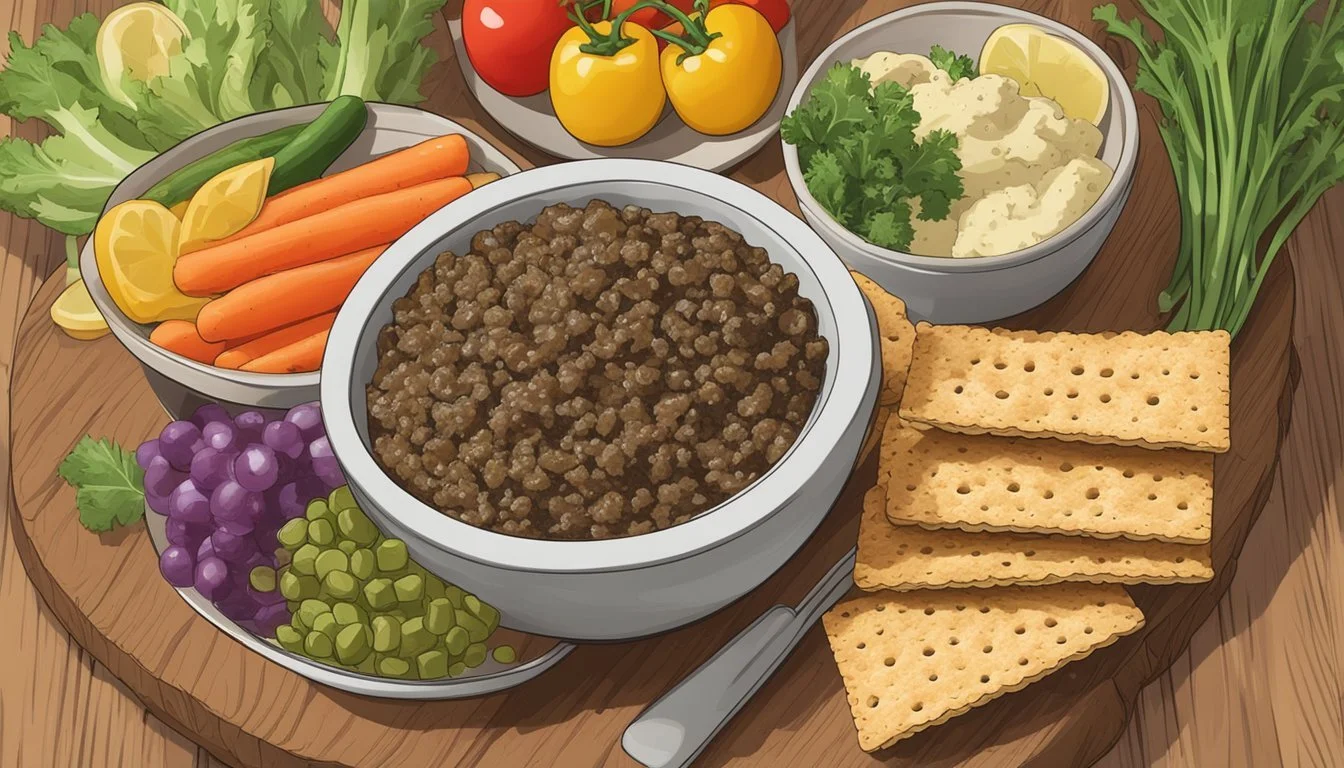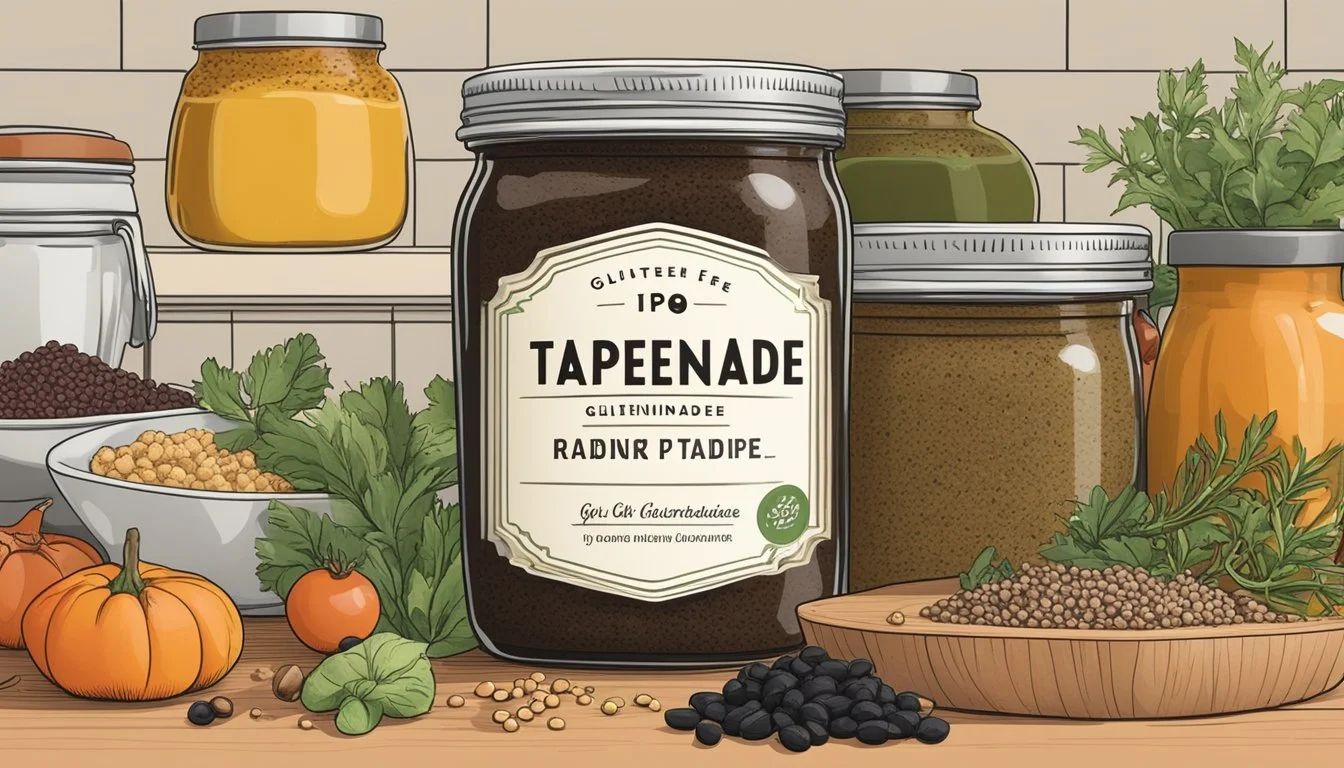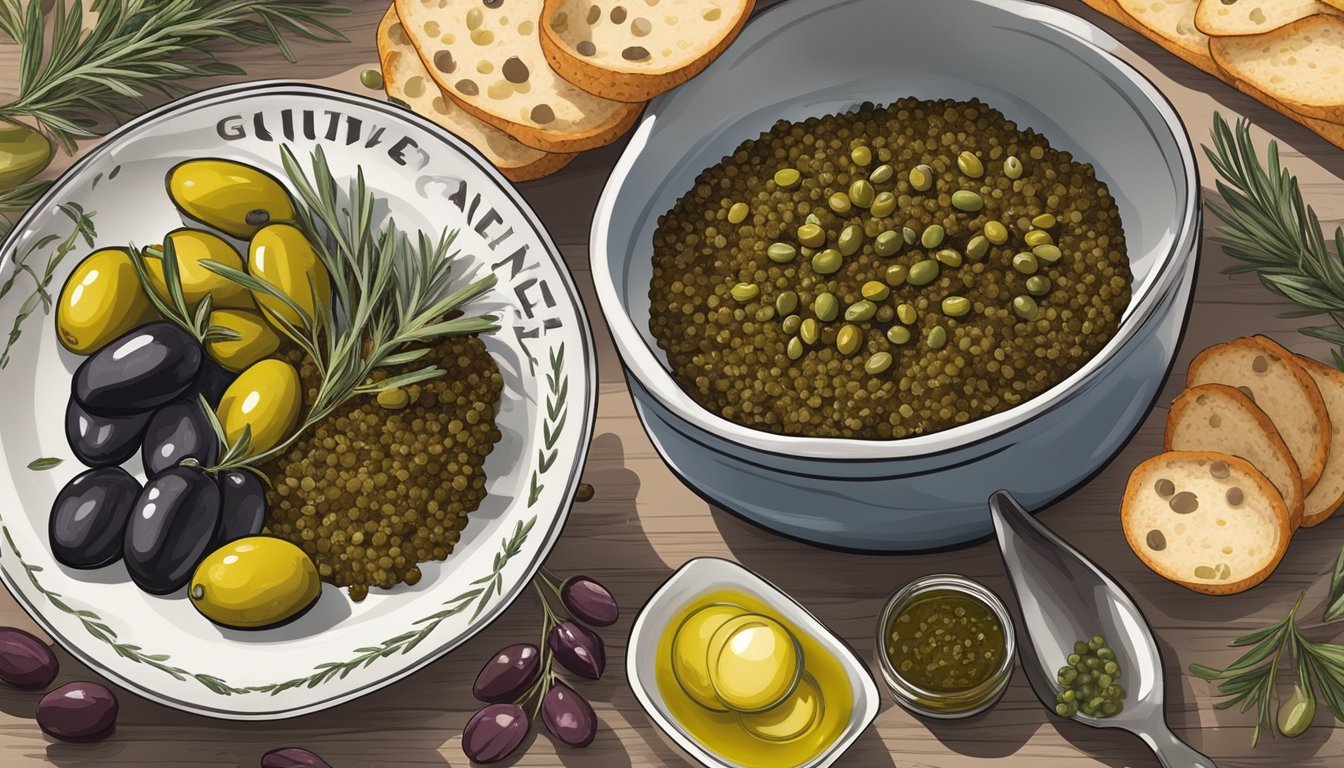Is Tapenade Gluten-Free?
Understanding Its Ingredients and Preparation
Tapenade is a popular spread, often featured as an appetizer on Mediterranean tables and beloved for its rich, savory flavors. Characteristically, it consists of olives – typically Kalamata or a mix of green and black varieties – along with capers, (What wine goes well with capers?) anchovies, (What wine goes well with anchovies?) garlic, lemon juice, and olive oil blended into a thick paste. Gluten, a protein found in wheat, barley, rye, and derivatives thereof, is not an inherent part of this appetizer's traditional recipe, suggesting that tapenade is naturally gluten-free.
However, the gluten-free status of any tapenade hinges on the specifics of its preparation and ingredients. For instance, if additives like thickeners or flavored ingredients containing gluten are used, this would compromise its gluten-free integrity. Additionally, cross-contamination is a potential risk if tapenade is made in a facility that also processes gluten-containing foods, which emphasizes the importance for those with celiac disease or gluten sensitivities to verify the product's purity.
In summary, olive tapenade can be considered gluten-free when made with pure, uncontaminated ingredients. Due to potential variations in recipe and manufacturing practices, it is always prudent for consumers to inspect labels and, if necessary, reach out to manufacturers to confirm the absence of gluten.
Understanding Tapenade
Tapenade is a traditional Mediterranean spread primarily made from olives, capers, anchovies, and olive oil. It typically includes other flavor-enhancing ingredients such as garlic, lemon juice, and herbs like basil or parsley. The name 'tapenade' stems from the Provençal word for capers, 'tapenas'.
Key Ingredients
Olives: The foundation of the spread, offering a rich, savory flavor.
Capers: These provide a briny, tangy taste.
Anchovies: They add a salty depth, enhancing the spread's umami character.
Olive Oil: Used to achieve the right consistency and add a smooth, rich mouthfeel.
Garlic: Adds a pungent accent to the mix.
Lemon Juice: Contributes a fresh zesty note.
Herbs: Basil and parsley are commonly used for their fresh, aromatic qualities.
Texture and Use The texture of tapenade can vary from chunky to smooth, depending on the recipe and desired consistency. It's often used as a spread on bread or crackers, as a dip, or as a condiment with various dishes.
Preparation Tapenade is generally easy to prepare, with many recipes incorporating a simple blend of the ingredients in a food processor until the desired texture is reached. It's important to note that the proportions and specific ingredients might vary, providing a range of flavors and textures within the spectrum of tapenade recipes.
In summary, tapenade is an olive-based spread featuring a medley of ingredients that together create a richly flavored and versatile Mediterranean staple.
Key Ingredients and Variations
In exploring whether tapenade is gluten-free, one must consider the ingredients used. Traditional tapenade recipes rely on simple, naturally gluten-free components, but variations may introduce items that contain gluten. It's essential to understand the core ingredients and potential substitutes to ensure the final product is suitable for those with gluten sensitivities.
Traditional Ingredients
Typically, a classic olive tapenade recipe will include a base of olives—often kalamata or black olives—which provide the primary flavor and texture. Additional foundational ingredients include capers, anchovy paste (or fillets), and garlic cloves. These are blended together with extra virgin olive oil to create the desired consistency, and lemon juice or lemon zest is added to brighten the flavors.
Olives: Black or kalamata
Capers
Anchovy Paste
Garlic Cloves: Usually one or two
Olive Oil: Preferably extra virgin
Lemon: Juice or zest for a fresh kick
Substitute Ingredients
For a green olive tapenade, one can substitute green olives in place of black or kalamata varieties. This substitution can impact the tapenade's flavor, giving it a more robust and slightly tangier taste. Those avoiding animal products can omit the anchovies for a vegan friendly option, though it will change the traditional flavor profile.
Green Olives: A tangier alternative to black olives
Olive Oil Substitutes: For a different fat content, one might choose a lighter olive oil or different oils altogether
Vegan Options: Remove anchovies for a vegan-friendly tapenade
Adding Flavors and Textures
Different recipes may call for varying additional flavors and textures. The introduction of ingredients such as herbs, nuts, or sun-dried tomatoes can alter the tapenade significantly. It's pivotal to ensure that any extra components, like seasoned crackers or bread served with the tapenade, are gluten-free to maintain the dish's gluten-free integrity.
Herbs: Thyme or basil can complement the olives and capers
Nuts: Pine nuts or almonds for added texture
Accompaniments: Ensure crackers or bread are gluten-free if serving with tapenade
Assessing Gluten Presence
When evaluating whether tapenade is gluten-free, it is essential to scrutinize the ingredients and be vigilant about potential sources of hidden gluten that could turn an otherwise safe spread into a risk for individuals with gluten sensitivities.
Common Gluten-Containing Ingredients
Tapenade traditionally consists of olives, capers, anchovies, and olive oil—ingredients that lack gluten naturally. However, some recipes or commercial products may include additives like thickeners or flavorings that contain gluten. Therefore, it is imperative to examine each ingredient. Here are typical components that could contain gluten:
Stabilizers or fillers in pre-packaged items
Seasonings or mixed seasonings
Any wheat-based components (e.g., wheat flour)
For a gluten-free tapenade, the careful selection of ingredients is paramount. The preparation should occur in a gluten-free environment to avoid cross-contamination.
Auditing for Hidden Gluten
Even when the direct ingredients of tapenade are gluten-free, cross-contamination remains a concern. "Hidden Gluten" could still be present if the ingredients were processed on shared equipment with gluten-containing foods. To ensure a gluten-free status, one should:
Check labels for certifications: Gluten-free certified products have been tested for gluten presence.
Inquire about processing practices: When shopping for ingredients like olives, capers, or anchovies, one should ask manufacturers about their processing methods to confirm the absence of gluten.
Use a dedicated food processor: During the making of tapenade, using a kitchen appliance that has only been used for gluten-free foods will help maintain a gluten-free serving.
A tapenade achieves the desired consistency without needing gluten-rich thickeners, and a pure blend of the traditional ingredients will typically contain no gluten. However, safeguarding against hidden sources requires diligence both in selecting ingredients and in auditing preparation methods.
Gluten-Free Recipe Adaptations
When adapting recipes to be gluten-free, the focus should be on substitutions that maintain the integrity and flavor of the dish. This is particularly true for creating gluten-free tapenade, which traditionally may already fall into this category, provided the ingredients used do not contain gluten.
Modifying Traditional Recipes
A primary concern in gluten-free cooking is the replacement of wheat-containing ingredients. Ingredients such as breadcrumbs or crackers, often used for consistency or as fillers in traditional tapenade recipes, must be substituted with gluten-free alternatives. Gluten-free breadcrumbs or crumbled gluten-free crackers are suitable options.
Flours: For thickening or binding, select gluten-free flour blends that replicate the properties of all-purpose wheat flour.
Another consideration is cross-contamination. It is essential to use prep surfaces, utensils, and cooking equipment that haven't come into contact with gluten to ensure the safety of the dish.
Creating a Gluten-Free Tapenade Base
Olive tapenade, a Mediterranean spread, usually combines olives, capers, and anchovies. To craft a gluten-free version, scrutinize each ingredient for hidden sources of gluten. Start with naturally gluten-free base ingredients:
Olives: Utilize any variety, such as Kalamata or green olives.
Capers: Typically gluten-free, add briny flavor.
Anchovies: Ensure they’re not marinated in a sauce containing gluten.
For a vegetarian or vegan adaptation, omit anchovies and use a combination of olives and capers. Incorporate fresh herbs like parsley or thyme and zest from lemons for added zing.
Prep time is minimal, with the bulk of the effort in ensuring ingredients meet gluten-free standards.
Preparation: Pulse the combination in a food processor until coarsely chopped - do not purée.
The resulting spread should be bold, with each ingredient finely balanced to create a versatile accompaniment suitable for a host of servings such as on gluten-free crackers or as a condiment for grilled meats and vegetables.
Serving Suggestions and Pairings
Tapenade, renowned for its bold flavor, is a versatile condiment that can be paired with a variety of foods. Its gluten-free nature makes it an excellent choice for those with dietary restrictions. Enhancing the taste of many dishes, tapenade serves as a delectable appetizer when presented with the right accompaniments.
Gluten-Free Breads and Crackers
Gluten-Free Breads: For individuals who follow a gluten-free diet, tapenade can be spread onto various gluten-free bread options. Whether choosing a baguette, toast, or sandwich bread, ensure they are specifically labeled as gluten-free.
Toasted Baguette Slices: Lightly toast thin slices of gluten-free baguette for a crunchy texture.
Gluten-Free Sandwich Bread: Spread tapenade on sandwich bread for a flavorful twist to ordinary sandwiches.
Crackers: There is a wide array of gluten-free crackers available that pair perfectly with tapenade. Opting for crackers with minimal flavors lets the tapenade shine as the star.
Rice crackers: Offer a light, crisp texture suitable for the tapenade's robust taste.
Nut-based crackers: These provide an added depth to the appetizer's flavors.
Versatile Dishes with Tapenade
Tapenade's flexibility extends beyond bread and crackers, enriching the taste of various dishes.
Bruschetta and Crostini: Top gluten-free crostini or bruschetta with tapenade for a traditional Italian appetizer.
Pizza and Pasta: A spoonful of tapenade added to gluten-free pizza or pasta contributes an intense flavor dimension.
Salads: Incorporate tapenade into salads as a dressing ingredient or a mix-in to elevate the dish's profile.
Cheese Boards: Accompanying cheeses and fruits, tapenade on a cheese board adds a savory touch that complements the board's other elements.
Pairing tapenade with gluten-free options as an appetizer or within meals can enhance the dining experience for those with gluten sensitivities without sacrificing taste or variety.
Entrusting the Right Ingredients
When making gluten-free tapenade, it is crucial to select ingredients that are both safe for those with gluten sensitivities and of high quality to ensure the best flavor. Careful attention to product labels and certifications will assist in maintaining a gluten-free diet.
Selecting Certified Gluten-Free Products
To ensure that tapenade ingredients are gluten-free, individuals should look for certifications from trusted organizations on the packaging. Certified gluten-free symbols indicate that the product has undergone rigorous testing to meet established gluten-free standards. For key tapenade components:
Olives: Olives are naturally gluten-free, but one must ensure there is no cross-contamination during processing.
Capers: Same as olives, they are inherently gluten-free but check for a certified gluten-free mark.
Anchovies: Often gluten-free; however, some brands may use additives that contain gluten, so always verify the label.
The following is a quick checklist to help identify gluten-free products:
Certified Gluten-Free Mark: Look for this seal on the label.
Ingredient List: Review for hidden sources of gluten.
Allergy Information: Check for mentions of gluten or wheat.
Cross-Contamination Warnings: Some products may be manufactured in facilities that also process gluten-containing foods.
Brands and Labels to Consider
It is important to familiarize oneself with brands that are recognized for their gluten-free products. The reputation of a brand can serve as a guideline when selecting gluten-free tapenade ingredients. Here are some considerations:
Look for brands that advertise as being exclusively gluten-free, reducing the risk of cross-contamination.
Many brands now label their products as gluten-free, but always confirm that this claim is backed by certification.
Vegan or dairy-free labels oftentimes accompany gluten-free certifications, catering to broader dietary needs.
Be aware that brands can change their manufacturing processes, so regular review of product labels and nutrition information is key to staying up-to-date with gluten-free options.
Health Considerations and Nutritional Value
When considering tapenade for its health contributions and nutritional value, one should examine its calorie breakdown, nutrient content, and compatibility with various diets such as gluten-free, vegan, or vegetarian lifestyles.
Caloric and Nutrient Content
Tapenade's primary ingredient, olives, contribute to its calorie count while also providing heart-healthy monounsaturated fats, notably oleic acid, which is abundant in olive oil. A typical tapenade recipe may contain the following estimate of nutrients per 2 tablespoon serving:
Calories: 60-80
Total Fat: 5-7g
Saturated Fat: Less than 1g
Carbohydrates: 1-3g
Fiber: 1-2g
Protein: 0-1g
Sodium: 300-400mg
Iron: Varies depending on ingredients
It's also important to note that while olives and other common ingredients like capers and garlic contribute micronutrients such as iron and trace amounts of fiber, tapenade can be high in sodium due to the brined nature of the olives and capers.
In terms of dietary considerations, traditional tapenade is naturally gluten-free, making it a suitable choice for individuals with gluten intolerance or celiac disease. It is also inherently vegan and vegetarian, though non-vegan versions may include anchovies.
Olive oil, often used to achieve a spreadable consistency, is rich in antioxidants and has been associated with various health benefits, potentially reducing inflammation and lowering the risk of chronic diseases. However, portion control is advised due to the high caloric density of fats.
By and large, tapenade can be considered a nutrient-dense food that is gluten-free and compatible with vegan and vegetarian diets, provided any added ingredients adhere to these requirements.
Tools and Techniques for Homemade Tapenade
Creating a homemade tapenade requires specific kitchen equipment to achieve the desired texture and consistency. The process is straightforward, and with the right tools, one can make a delicious spread perfect for various dishes.
Must-Have Kitchen Equipment
Food Processor: Modern recipes for tapenade usually call for a food processor, which is the central tool for combining ingredients quickly and efficiently. It should be fitted with a sharp blade capable of chopping the ingredients into a cohesive mixture.
Measuring Spoons and Cups: Precision matters in cooking, so having a set of measuring spoons and cups on hand will ensure that the ingredients are accurately proportioned.
Mixing Bowls: A set of mixing bowls may be needed to hold prepped ingredients before they’re added to the food processor.
Refining Texture and Consistency
The texture of homemade tapenade significantly influences its quality. A food processor allows for control over this aspect:
Pulse vs. Continuous Blending: For a chunkier texture, one should use short pulses to chop the ingredients. For a smoother paste, continuous blending is required.
Oil Addition: Gradually drizzling in the olive oil while the food processor is running can help emulsify the mixture and achieve a spreadable consistency.
By carefully selecting your equipment and refining the techniques used in preparing tapenade, one can ensure that their homemade version has the right consistency and a professional-quality texture.
Preservation and Storage Tips
Ensuring the freshness and longevity of tapenade involves proper storage techniques and an understanding of how to preserve its quality over time. These best practices are crucial regardless of whether one is storing homemade tapenade or a store-bought variety.
Maximizing Shelf Life
When storing tapenade, the total time it remains fresh is of primary concern. To maximize shelf life, it is imperative to keep the tapenade in an airtight container, which minimizes exposure to air and potential contaminants. Before sealing, one may press a piece of plastic wrap directly onto the surface of the tapenade to further reduce air contact.
Before Opening:
Store unopened jars in a cool, dark place.
Check best-by dates to ensure freshness after opening.
After Opening:
Utilize plastic wrap to cover the spread's surface.
Seal with an airtight lid to maintain quality.
Proper Storage Practices
Proper Storage Practices involve the refrigerator once the seal of the tapenade has been broken. To maintain the quality of the spread, refrigeration is necessary as it slows bacterial growth, maintaining the flavors of the olives and capers.
Refrigerator Storage:
Store in the refrigerator at temperatures below 40°F (4°C).
Keep tapenade in the airtight container on a shelf rather than the door to avoid temperature fluctuations from frequent opening.
Serving:
Remove only the amount of tapenade needed to avoid repeated warming and cooling, which can degrade quality.
For best results, let it sit at room temperature for a few minutes before serving to enhance the spreadability.











